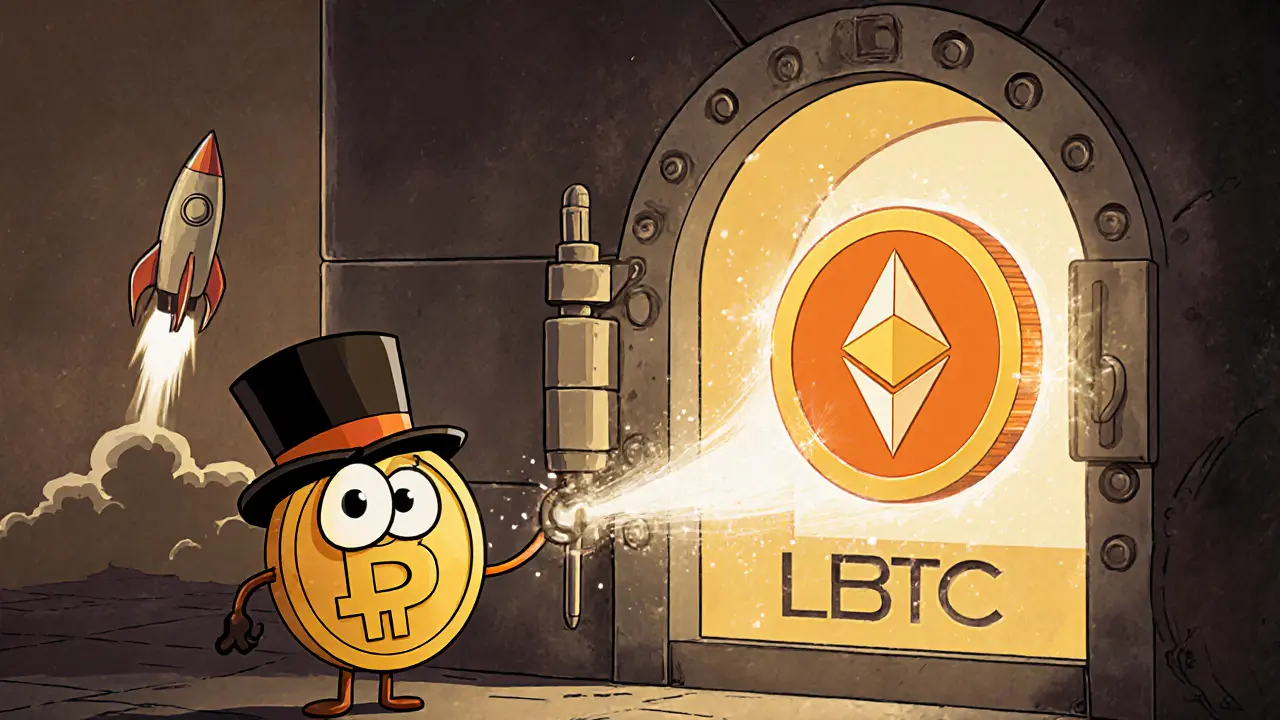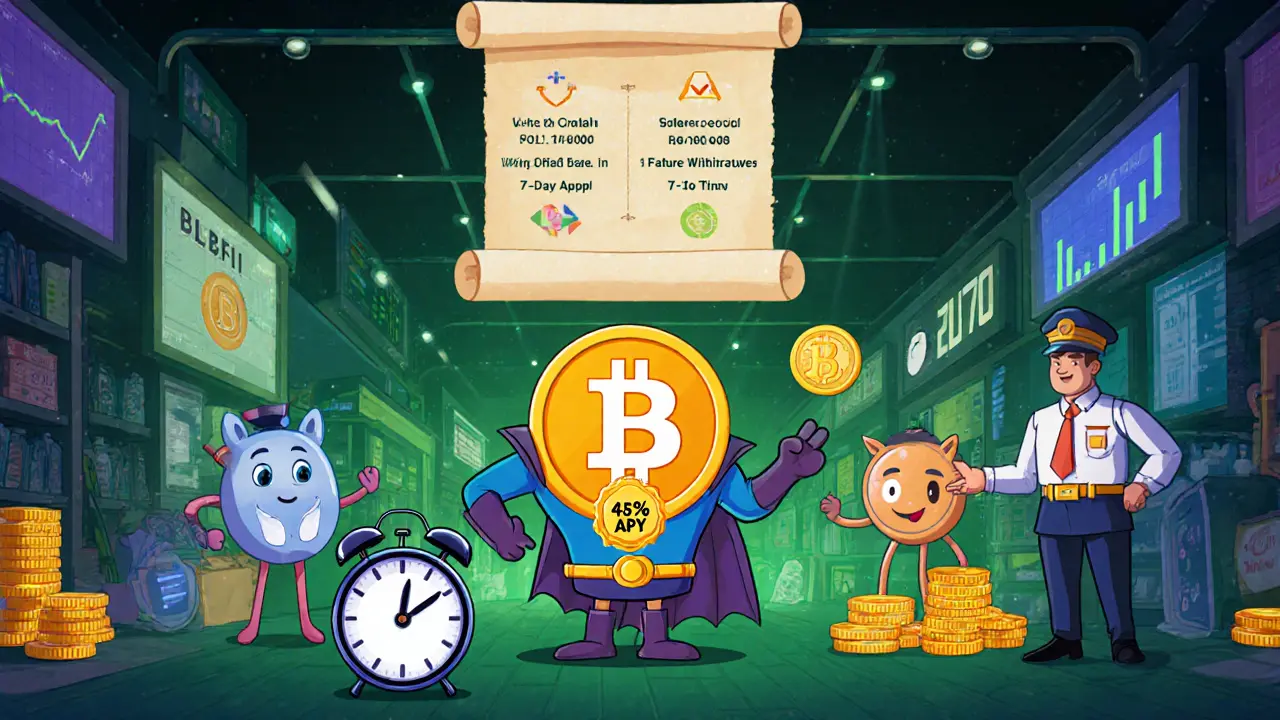Lombard Staked BTC (LBTC) Explained: How the Bitcoin Liquid Staking Token Works

Oct, 22 2025
LBTC Staking Yield Calculator
Calculate Your LBTC Staking Returns
LBTC provides 4-5% APY on your staked Bitcoin. Input your BTC amount and time period to see projected returns.
Lombard Staked BTC (LBTC) is a liquid staking token that represents Bitcoin (BTC) staked through the Babylon protocol on the Ethereum network. It lets Bitcoin holders turn their BTC into a fully collateralized ERC‑20 token while still earning yield from the underlying Bitcoin's participation in proof‑of‑stake (PoS) security layers. In simple terms, you lock BTC, receive a 1:1 backed LBTC token, and can instantly use that token across DeFi protocols without moving the original Bitcoin.
What LBTC Is and How It Works
LBTC belongs to the family of Liquid Staking Tokens (LSTs). Unlike wrapped Bitcoin (WBTC) that merely mirrors BTC price, LBTC actually stakes the underlying Bitcoin on the Babylon restaking layer. Babylon takes the locked BTC and uses it to secure various PoS networks, generating staking rewards that automatically increase the LBTC‑to‑BTC exchange rate. Users never need to claim rewards - the token’s value rises on its own.
Technical Architecture Behind LBTC
The protocol stacks three main components:
- Bitcoin side: Users send BTC to a custodial‑free address managed by Lombard. After six Bitcoin confirmations (≈1 hour), a cryptographic proof is generated.
- Babylon layer: The proof is submitted to Babylon, which restakes the BTC across multiple PoS networks, similar to EigenLayer but with Bitcoin as the stake asset.
- EVM side: Once Babylon validates the proof, an equivalent amount of LBTC is minted on Ethereum (or other EVM chains). The ERC‑20 token follows the standard
totalSupply = amount of BTC locked.
Burning LBTC follows the reverse path. Users send LBTC back to the Lombard contract, trigger a mandatory 7‑day withdrawal period for security, and then receive the original BTC on the Bitcoin blockchain.
Yield Generation and Staking Rewards
Every day Babylon distributes a portion of the staking rewards to the LBTC pool. Because the rewards are denominated in Bitcoin, the LBTC‑to‑BTC exchange rate rises incrementally. As of October 23 2025, the average annualized yield hovers around 4‑5 % APY, comparable to other Bitcoin restaking solutions but higher than WBTC, which offers no native yield.

Comparing LBTC to Other Bitcoin DeFi Solutions
| Feature | LBTC | WBTC | Stacks (STX) | Custodial Staking |
|---|---|---|---|---|
| Backing | 1 BTC per LBTC (non‑custodial) | 1 BTC per WBTC (custodial) | Layer‑2 token, not direct BTC backing | BTC locked with a centralized custodian |
| Yield | 4‑5 % APY (auto‑compounding) | 0 % (price‑only) | Variable, protocol‑specific rewards | Variable, often higher but counterparty risk |
| Liquidity | Immediate ERC‑20 liquidity on EVM chains | Immediate ERC‑20 liquidity | Limited to Stacks ecosystem | Liquidity depends on custodian policies |
| Withdrawal time | 7 days (security period) | Instant (on‑chain transfer) | Depends on layer‑2 exit rules | Usually 1‑3 days, but can be delayed |
| Security model | Bitcoin + Babylon + Ethereum security (decentralized consortium) | Bitcoin + custodian security | Stacks PoX security | Custodian trust model |
LBTC’s unique selling point is that it actually uses Bitcoin to secure PoS networks, turning the world’s largest store of value into a yield‑bearing asset.
Risk Factors and Security Considerations
While LBTC eliminates many of the drawbacks of traditional Bitcoin staking, it introduces its own set of risks:
- Dual‑chain dependency: A failure on either Bitcoin or Ethereum could affect token redemption.
- Smart‑contract bugs: The ERC‑20 contract and Babylon’s bridge are open‑source but still subject to audit findings.
- Withdrawal latency: The 7‑day period is a security safeguard; it can feel restrictive during volatile market moves.
- Validator centralization: If too many Babylon validators stake on the same PoS chain, concentration risk rises.
Independent auditors (RedStone, Kiln) give Lombard’s security a “Good” rating, but the broader DeFi community still watches the cross‑chain bridge closely. Vitalik Buterin’s 2024 caution about Bitcoin restaking emphasizes that any weakness could cascade across multiple PoS networks.
Getting Started: Minting and Unstaking LBTC
Here’s a quick roadmap for a typical user who already has a Bitcoin and an Ethereum wallet:
- Open the Lombard web UI and connect your Ethereum wallet (MetaMask, Coinbase Wallet, etc.).
- Copy the unique Bitcoin deposit address shown on the dashboard.
- Send the desired amount of BTC to that address. Wait for six confirmations (≈1 hour).
- After confirmations, click “Generate Proof” in the UI. The system creates a Merkle proof linking your BTC transaction to the Babylon layer.
- Submit the proof; the Lombard contract mints an equal amount of LBTC on Ethereum. The tokens appear in your wallet within minutes.
- To unstake, send LBTC back to the contract and request a withdrawal. The 7‑day timer starts.
- After the period, Lombard releases the original BTC to the Bitcoin address you specified during the request.
During high‑traffic periods, Ethereum gas fees can spike. Users often switch to a Layer‑2 solution (Arbitrum, Optimism) once LBTC support lands there, cutting fees dramatically.

Recent Developments and Future Roadmap
October 10 2025 saw a partnership with Aave, allowing LBTC to serve as collateral for borrowing USDC and other stablecoins. This move unlocked a new use‑case: leveraging Bitcoin‑derived yield while still accessing liquidity.
Looking ahead, Lombard plans to:
- Launch native governance via the upcoming BARD token (Q1 2026).
- Deploy LBTC on five additional EVM‑compatible chains, including Binance Smart Chain and Polygon, by mid‑2026.
- Reduce the withdrawal period from 7 days to as low as 3 days, pending security enhancements.
- Introduce secondary yield streams beyond Babylon’s native rewards, such as staking LBTC in Layer‑2 liquidity pools.
Analysts at Messari project that Bitcoin restaking protocols could capture up to 10 % of Bitcoin’s market cap within five years, meaning LBTC’s TVL could someday reach double‑digit billions if security holds up.
Community Feedback and Market Position
As of October 23 2025, LBTC’s market cap sits at $1.718 billion with a circulating supply of 14,586 tokens, ranking it 87th on CoinGecko. Daily transaction volume averages 120 BTC, and over 1,200 unique staking events have been recorded on DappRadar.
Reddit users praise the instant DeFi composability but warn newcomers about the initial minting complexity and the 7‑day lock‑up. Trustpilot’s 3.7/5 rating reflects a blend of enthusiasm and mild frustration over withdrawal delays. The Discord community, though modest at ~4,200 members, is active with “#getting‑started” and “#governance‑talk” channels.
Key Takeaways
- LBTC is the first fully collateralized Bitcoin liquid staking token, turning BTC into a yield‑bearing ERC‑20.
- Staking rewards are auto‑compounded, giving a current 4‑5 % APY without manual claims.
- Liquidity is immediate on Ethereum, but withdrawing BTC requires a 7‑day security period.
- Security depends on both Bitcoin and Babylon/Ethereum bridges; audits rate it “Good” but watch for cross‑chain bugs.
- Future roadmap targets multi‑chain expansion, governance token launch, and faster withdrawals.
How does LBTC maintain a 1:1 backing with Bitcoin?
When you deposit BTC, Lombard locks the exact amount on the Bitcoin blockchain. A cryptographic proof is then generated and submitted to Babylon, which mints an equal number of LBTC tokens on the Ethereum network. The smart contract holds the proof, ensuring each LBTC token is always redeemable for one BTC.
Can I use LBTC on DeFi platforms other than Aave?
Yes. LBTC is an ERC‑20 token, so any protocol that accepts standard ERC‑20 assets can interact with it. Users have already supplied LBTC to Uniswap, Curve, and Compound for liquidity provision and borrowing.
What happens if the Babylon protocol is compromised?
A breach could affect the underlying staking rewards and potentially halt new minting, but the locked BTC would remain on the Bitcoin chain under Lombard’s multi‑signature custody. Users could still burn LBTC and retrieve their BTC after the withdrawal period, though the process might be delayed.
Is there a way to speed up the 7‑day withdrawal?
Currently no. The delay is a built‑in security measure to prevent front‑running attacks. Lombard’s roadmap mentions a possible reduction to 3 days once additional validator decentralization is achieved.
Do I need to pay gas fees when minting LBTC?
Yes. The proof submission and token minting steps occur on Ethereum, so you’ll pay the usual gas fees. During network congestion, consider using a Layer‑2 solution once LBTC support lands there.